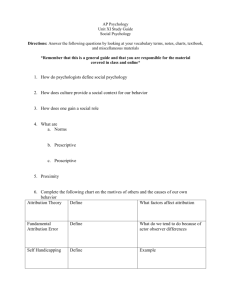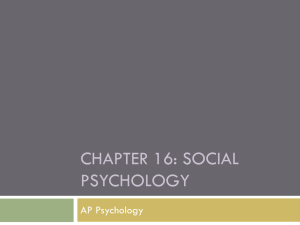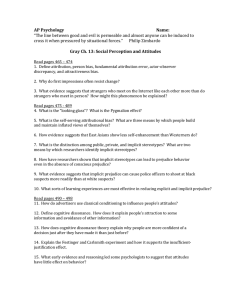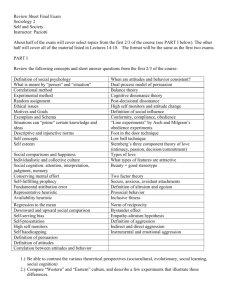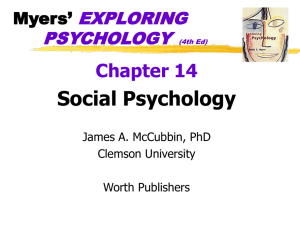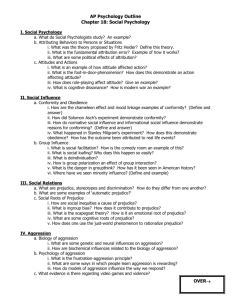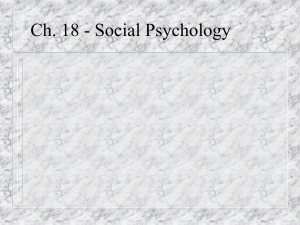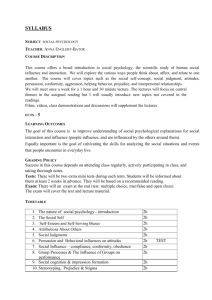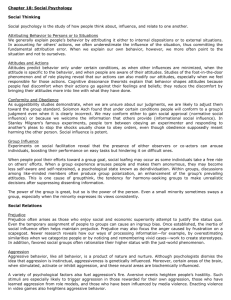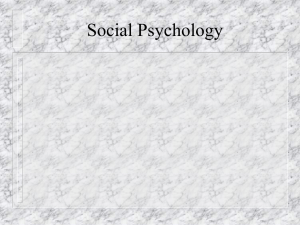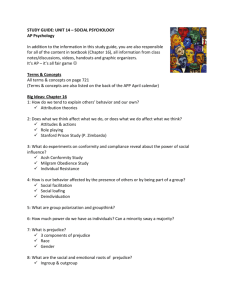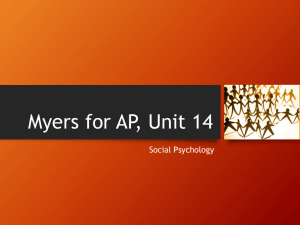Social Psychology Study Guide: Review Exam 1: Chapter 1
advertisement
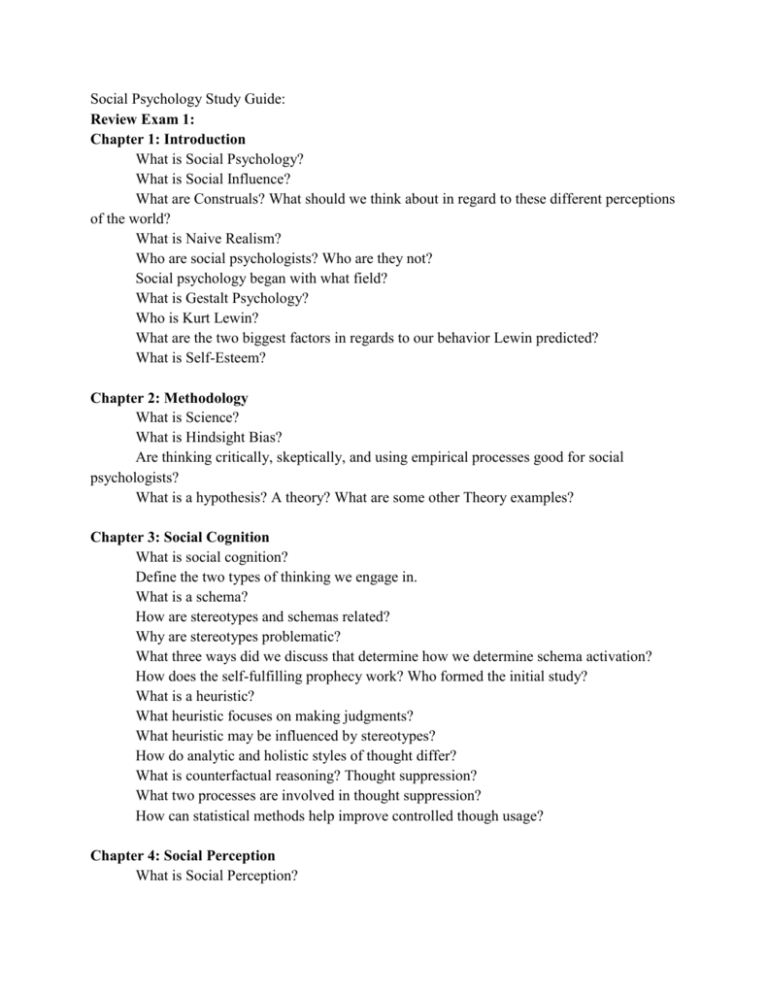
Social Psychology Study Guide: Review Exam 1: Chapter 1: Introduction What is Social Psychology? What is Social Influence? What are Construals? What should we think about in regard to these different perceptions of the world? What is Naive Realism? Who are social psychologists? Who are they not? Social psychology began with what field? What is Gestalt Psychology? Who is Kurt Lewin? What are the two biggest factors in regards to our behavior Lewin predicted? What is Self-Esteem? Chapter 2: Methodology What is Science? What is Hindsight Bias? Are thinking critically, skeptically, and using empirical processes good for social psychologists? What is a hypothesis? A theory? What are some other Theory examples? Chapter 3: Social Cognition What is social cognition? Define the two types of thinking we engage in. What is a schema? How are stereotypes and schemas related? Why are stereotypes problematic? What three ways did we discuss that determine how we determine schema activation? How does the self-fulfilling prophecy work? Who formed the initial study? What is a heuristic? What heuristic focuses on making judgments? What heuristic may be influenced by stereotypes? How do analytic and holistic styles of thought differ? What is counterfactual reasoning? Thought suppression? What two processes are involved in thought suppression? How can statistical methods help improve controlled though usage? Chapter 4: Social Perception What is Social Perception? What are some examples of non-verbal (NV) communication? What do mirror neurons have to do with NV communication? Who in 1872 suggested facial expressions were universal? In relation to facial expressions, what is encoding? What about decoding? What are our core 6 facial expressions? What are emblems? Explain Implicit Personality Theories. What is a US and Chinese specific IPT? Attribution Theory is the study of ________________. What is Heider’s Dichotomy? What is the Fundamental Attribution Error also called? Define it. What is self-serving bias? What type of attribution to we put on our successes, what about our failures? Review Exam 2 Chapter 5: The Self The self consists of 2 parts, what are they? What is self-knowledge? What are the two types of interdependence? which is associated with men? with women? What is Self-Awareness Theory? What is Self-Perception Theory? Rewards such as money or prizes are which type of motivator? what is the other? The over justification effect is defined as what? It will only undermine interest under what condition? What are the two factors to emotion that Shacter defined in 1964? What is the misattribution of arousal? What is social comparison theory? When do we use upward and downward social comparison? What is impression management? Chapter 6: The Need to Justify Our Actions What is cognitive dissonance? Its purpose is to maintain our _____________. In what 3 ways can we reduce dissonance? When making a decision our attitudes concerning our selections tend to be _______, and those for what we reject tend to be ___________. What factor can increase our need to reduce dissonance to build support of a decision as see in Gilbert and Ebert (2002). Can dissonance change our attitudes? What do we mean by a justification of effort? What do we mean by external and internal justification? What is counter attitudinal advocacy? What is the most effective punishment for long term change? Chapter 7: Attitudes and Attitude Change What are attitudes? What are the 3 types of attitudes? What is the difference between an implicit and an explicit attitude? The Yale Attitude Change Approach focuses on what 3 aspects of the message? The elaboration likelihood model states we have what 2 routes to persuasion? A core personality variable that plays a role in the central route is a need for what? What is Attitude Inoculation? Does subliminal messaging work? Chapter 8: Conformity What is meant by conformity? What is informational social influence? what drives it? What do we mean by public compliance and private acceptance? What is Contagion in relation to social psychology? What is normative social influence? what drives it? What are social norms? Who is Solomon Asch? What were his 1950s studies about? Social Impact Theory states we conform depending on 3 factors, what are they? What is the difference between an Injunctive and a Descriptive norm? Which seems to be more powerful at influencing behavior? Know the Milgram study. Review Exam 3 Chapter 9: Group Processes What is a group? what is the difference between a social norm and a social role? Know the Zimbardo prison experiment. What is social facilitation? What about social loafing? Why does deindividuation occur? What theory of group decision was developed by Irving Janis? Define it. How can we avoid groupthink? What are the two leadership styles? What is a social dilemma in psychological research? Chapter 10: Interpersonal Attraction What is propinquity? What does the mere exposure effect state? What is similarity in relation to attraction? What is the core stereotype concerning beauty and attraction? What are some aspects of it? What is one explanation that may explain why attractive people are more socialable? (hint: we discussed it in another chapter) What two types of love do we define? While a concept of love is universal, what could determine a change in definition? Chapter 11: Prosocial Behavior What is prosocial behavior? What is altruism? What is the reciprocity norm? What is the empathy-altruism hypothesis? Can engaging in prosocial behavior change mood? What is the urban-overload hypothesis? What is the bystander effect? Chapter 12: Aggression What is aggression? How do hostile and instrumental aggression differ? Aggression for pure violence (not for display, to get food, or from fear) is generally seen in only 2 animal species, what are they? What area of the brain is associated with aggression? What neurotransmitter may inhibit aggressive impulses? What hormone is associated with aggression? What is the Frustration-Aggression Theory? What is mean by an aggressive stimulus? What is social learning theory? What is desensitization? How does catharsis help with reducing aggression? Chapter 13: Prejudice What is prejudice? What is the cognitive component? the behavioral component? Why are stereotypes problematic even if they seem beneficial? What is discrimination? While we might argue the general nature of prejudices formation, social psychologists do agree that the specifics have to be ___________. Can stereotypes be activated? What is the Justification-Suppression Model of prejudice? What is the Illusory Correlation in regard to prejudice? What is stereotype threat? What is realistic conflict theory? What is likely to happen is no clear reason exists but a minority group with few rights does? What was wrong with the contact hypothesis?
